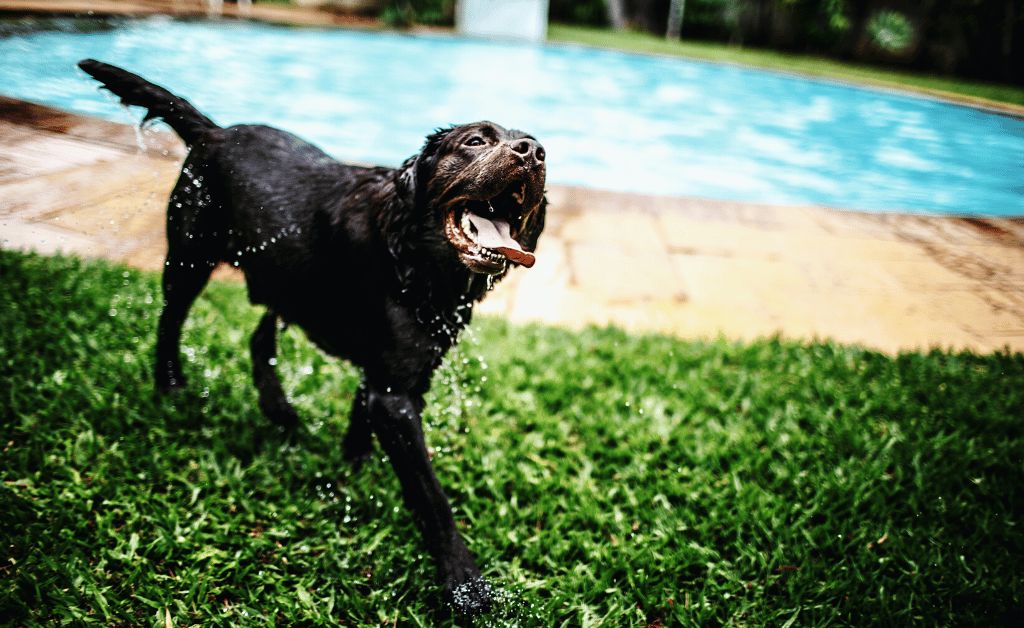Guard Dog or Gentle Giant: Are Labradors Protective?
As someone who has spent much time with various breeds, I’ve found Labrador Retrievers one of the most endearing and popular breeds worldwide. These lovable Labs, known for their friendly demeanor, intelligence, and adaptability, have won the hearts of many families, hunters, and even law enforcement agencies. But amidst all their charming traits, there’s a question that often pops up in conversations, “Are Labradors protective?”
Today we want to explore that question. Digging deep into whether or not Labradors can offer an effective line of defense against intruders or threats. So stick around for more insight on this topic as we examine why Labradors make great personal protectors!
Understanding the Labrador Temperament
Labrador Retrievers, affectionately known as Labs, are renowned for their consistently friendly and outgoing temperament. They are often characterized by their warm, pleasant nature, which makes them excellent companions for families and individuals, and even as therapy or service dogs.
One of the defining traits of Labradors is their eagerness to please. They are incredibly loyal and often form strong bonds with their human family members. This attribute and their high intelligence make them very responsive to dog training. They learn quickly and are always eager to engage in activities that stimulate them mentally and physically.
Labs are also known for their playful and active disposition. They are high-energy dogs that require regular exercise to keep them healthy and content. Whether it’s a game of fetch, a walk in the park, or a swim in the lake, Labs are always up for physical activities.
Despite their energetic nature, Labradors are known for their calm and patient demeanor. They are not typically aggressive and are generally tolerant, making them excellent pets for families with children. They are friendly dogs who get along well with other animals and people.
When it comes to their protective instincts, people don’t recognize Labradors as guard dogs. They are loyal to their families and can exhibit protective behavior if they perceive a threat to their loved ones. However, their friendliness and love for people often outweigh their protective instinct.
Labradors as Guard Dogs: Are Labradors Protective?
When picturing a Labrador Retriever, the image that springs to mind is often one of a friendly, tail-wagging companion, always ready for a game of fetch. However, due to their size and intelligence, some people also wonder if they might make Labradors good guard dogs. Let’s explore this common misconception.
📍The Perception of Labradors as Guard Dogs
The idea of Labradors as guard dogs primarily stems from their impressive physical attributes. Labs are large, strong dogs with powerful bark, which can certainly be intimidating to anyone unfamiliar with the breed. Their high intelligence and trainability also contribute to this perception. Thanks to their keen senses and quick learning abilities, labradors are known to excel in various fields, such as search and rescue operations, detection work, and even as service dogs.
Additionally, Labradors are known for their loyalty towards their families. This loyalty can sometimes translate into protective behavior, especially when they perceive a potential threat to their loved ones.
For example, I remember an incident where my neighbor’s Lab showed a surprising display of protective behavior. A stranger had wandered onto their property, and the dog immediately positioned himself between the stranger and his family, barking loudly until the person left. It was a rare moment that highlighted Labs protective instincts of an otherwise friendly and cheerful dog.
However, while these factors might suggest that Labradors could make good guard dogs, it’s essential to understand the inherent temperament of the breed. Labradors are renowned for their friendly and pleasant nature. They love meeting new people and are likelier to greet a stranger with a wagging tail rather than suspicion or aggression.
Protective aggression works against the very nature of Labs, and any attempt to train them as guard dogs could be counter-productive. Therefore, while Labradors may exhibit protective behavior towards their family, they are not ideally suited as guard dogs.
So, while they may occasionally exhibit protective behavior, Labradors are not naturally inclined towards resource guarding or protective duties compared to other breeds like German Shepherds or Rottweilers.
📍Loyalty VS. Protectiveness: Understanding Your Labrador
The loyal nature of Labradors is one of their most endearing traits. They form strong bonds with their families and are known to stick by their side through thick and thin. This loyalty, however, can sometimes be misconstrued as protectiveness, particularly when a Labrador displays certain behaviors.
For instance, a Labrador might follow you around the house, watching your activities. They might position themselves between you and a stranger or even bark when someone unfamiliar approaches. While these behaviors may seem protective, they often stem from the dog’s inherent loyalty and affection for its human family.
Let me share an example from my personal experience. My Labrador, Bella, was always by my side, whether I was cooking in the kitchen, working in my home office, or relaxing in the living room. One day, a repairman came over to fix our heating system. As her usual friendly self, Bella greeted him with her wagging tail. However, she stayed close to me throughout his visit, keeping a watchful eye on the stranger. At one point, when the repairman moved toward the room where I was, Bella placed herself between us and let out a low growl.
While this incident might suggest that Bella was being protective, it was more about her being uncomfortable with the unfamiliar situation and person. Her loyalty and attachment to me made her stay close and keep a watchful eye on the stranger, not a natural instinct to guard or protect.
📍Labradors and Home Security: A Friendly Deterrent?
Regarding home security, Labradors are not typically the first breed that springs to mind. It is largely due to their friendly and sociable temperament, which makes them more likely to welcome a stranger with a wagging tail rather than a protective growl.
Labradors are known for their love of people. They thrive on social interaction and enjoy meeting new people, whether during a walk in the park or when visitors come to your house. While one of their most endearing traits, this friendliness doesn’t necessarily lend itself well to guard dog duties.
For example, my friend’s Labrador, Toby, epitomizes friendliness. Whenever I visit, he greets me at the door with his tail wagging furiously and a toy in his mouth, ready for a game of fetch. Even when I once had to enter their house when they were not home, Toby, instead of being suspicious or protective, greeted me with the same enthusiasm and affection.
It doesn’t mean Labradors can’t contribute to home security. Their size and bark can be a deterrent to potential intruders. Also, their loyal nature means they are likely to alert you to anything unusual happening around your home. However, if an intruder were to gain access to your home, a Labrador is likelier to offer them a warm welcome rather than act aggressively.
Protective Behaviors in Labradors
Labrador Retrievers, widely known for their friendly and pleasant disposition, are not typically associated with protective instincts in the same way as some other breeds, such as Great Dane, Dobermann, Bullmastiff, or Giant Schnauzer. They are naturally more inclined to greet strangers with a wagging tail and a playful nudge rather than suspicion or aggression.
Labradors are inherently loyal to their families. This loyalty can sometimes manifest as protective behavior in certain situations. For instance, if a Labrador perceives a potential threat to their loved ones, it might bark to alert its family or position itself between the perceived threat and its family members.
However, it’s important to note that these Labrador protective behaviors are usually more reactive than proactive. A Labrador is likelier to respond to an immediate threat rather than actively patrol or guard their home against potential intruders. Their primary instinct is towards friendliness and sociability, not protection or guarding.
Individual personality traits and experiences, rather than breed-specific characteristics, often influence whether some Labradors show more protective instincts than others. Training and socialization also play a significant role in shaping a dog’s behavior and responses.
💢Alert Barking Vs. Aggression: The Labrador’s Protective Stance
Labradors are known for their alertness and keen senses. They often quickly pick up on environmental changes and can respond by barking to alert their family members. It is one of the ways a Labrador may display protective behavior. However, it’s important to understand that alert barking differs from aggressive behavior.
For instance, if a Labrador hears an unfamiliar noise outside or sees someone approaching their house, they might bark to alert their family. This type of behavior is often more about alertness and communication rather than aggression or guarding.
One example of this comes from my experience with my Labrador, Lucy. Whenever someone approaches our front door, Lucy is quick to notice and starts barking. However, as soon as the door opens and she recognizes the person, her tail starts wagging, and she immediately switches to her friendly, sociable self.
It is a typical response from a Labrador. While they can quickly alert their family to potential threats through barking, they are unlikely to respond aggressively. Labradors are naturally friendly and sociable dogs. They typically greet strangers with enthusiasm and a wagging tail rather than suspicion or aggression.
It’s also worth noting that individual personality traits and experiences often influence whether some Labradors bark more than others. Training and socialization from a young age can also significantly affect how a Labrador responds to potential threats or unfamiliar situations.
💢The Deterrent Effect: Alert Barking and Home Intruders
While Labradors may not typically attack intruders, their alert barking can act as an effective deterrent against potential home intruders. The sound of a large dog barking can create uncertainty and fear in the mind of someone with ill intent, potentially causing them to reconsider their actions.
The mere size and presence of a Labrador and its strong bark can create an impression of a formidable obstacle. Even though Labradors are generally friendly, a potential intruder doesn’t necessarily know this. To them, a large, barking dog can pose a significant threat.
For instance, my neighbor’s Labrador, Daisy, once deterred a potential break-in at their home. Late one night, Daisy began barking loudly at the back door. My neighbor, waking up from the noise, noticed a figure trying to open their backyard gate. Upon hearing Daisy’s loud barks, the person quickly retreated and disappeared. Even though Daisy is one of the friendliest dogs you could meet, her alert barking was enough to deter a potential intruder.
However, it’s important to remember that while a Labrador’s barking can act as a deterrent, they are unlikely to respond aggressively if a person were to enter their home. Their primary instinct is toward friendliness rather than protection or guarding.
Factors That Influence a Labrador’s Protective Nature
Various factors often influence the protective nature of a Labrador or lack thereof. While they are naturally friendly and sociable dogs, elements such as training, socialization, and environment can play significant roles in shaping their behaviors and responses. Let’s delve deeper into these aspects.
✔Training: A Boost to Protective Instincts?
Training plays an essential role in shaping any dog’s behavior, and Labradors are no exception. While they might not have a natural inclination towards guarding or protective duties, certain training methods can enhance their alertness and responsiveness to potential threats.
For example, training your Labrador to bark on command or when they see someone approaching your property can effectively utilize their alertness for home security. However, it’s important to remember that training should always use positive reinforcement techniques and never encourage aggression.
A dog trainer once trained a Labrador named Rocky to bark whenever someone approached his home. His owner used treats and praise to encourage this behavior, and Rocky quickly learned to associate the sight of a person approaching with a positive response. It made him an effective deterrent against potential intruders, even though he was just as friendly and sociable as any other Labrador.
✔Socialization: Shaping the Labrador’s Worldview
Early socialization plays a crucial role in developing a Labrador’s understanding of its environment and how to respond to different situations. Exposing your Labrador to various people, environments, and situations from a young age can help them learn to differentiate between normal and potentially threatening scenarios.
For instance, a well-socialized Labrador will typically be friendly and relaxed around strangers but may become alert and wary if they sense unusual or threatening behavior. However, their response is likely more about alerting their family members rather than aggressive protection.
My friend’s Labrador, Daisy, is a great example of this. From a young age, an owner exposed her to various experiences and environments, which helped her become a well-rounded and adaptable dog. She’s friendly towards strangers but becomes noticeably alert if someone exhibits unusual or potentially threatening behavior.
✔Environment: The Impact on Protective Instincts
A Labrador’s upbringing and environment can significantly influence their protective instincts. Dogs raised in a safe, secure, loving environment will likely be more relaxed and confident. At the same time, those brought up in stressful or unpredictable situations may exhibit more protective or aggressive behaviors.
For example, a Labrador brought up in a busy household with many visitors will likely be more comfortable with strangers than one raised in a quiet home with little social interaction. Similarly, a Labrador with negative experiences with strangers might be more wary or protective compared to one with positive interactions.
Training a Labrador as a Guard Dog
Training a Labrador as a guard dog is a topic that often sparks debate among dog enthusiasts. Known for their friendly and sociable nature, Labradors are not the typical choice for guarding duties. However, with the right training, can they take on this role? Let’s explore this further.
‼The Guard Dog Debate: Can a Labrador Fit the Bill?
While people don’t traditionally regard Labradors as guard dogs, they can learn some protective behaviors with the right training. Labrador training methods focusing on enhancing their natural alertness, such as barking at unfamiliar noises or when someone approaches the property, can be effective. However, it’s important to remember that a Labrador’s primary instinct is friendliness rather than aggression.
Let’s consider my friend’s Labrador, Max. Max was trained from a young age to bark when someone approached their property. This behavior, combined with his size and the deep sound of his bark, made him an effective deterrent against potential intruders. However, once the person entered the property and Max recognized them as non-threatening, he immediately switched to his naturally friendly and sociable self.
It highlights that, although you can train Labradors to display certain protective behaviors, their effectiveness as guard dogs is limited. They are unlikely to respond with protective aggression if a person were to actually enter your property. Their instinct is towards friendliness and sociability, not protection or guarding. If you’re specifically looking for a dog with strong protective instincts, there are other guard dog breeds more suited to this role.
‼Early Training: Laying the Foundation for Protective Behaviors
Starting training early is crucial when trying to enhance a Lab protective instincts. Puppies are like sponges, ready to absorb information and learn new behaviors. By starting training early, you can effectively shape your Labrador’s responses and behaviors.
For instance, you can start by teaching your Labrador puppy basic obedience commands such as ‘sit,’ ‘stay,’ and ‘bark.’ Once they’ve mastered these, you can gradually introduce more complex commands related to protective behaviors, such as barking on command when they see someone approaching the property.
Remember, though, that you should always train using positive reinforcement techniques. Labradors, like all dogs, respond best to training methods that use rewards, praise, and affection. Negative or punishment-based training methods can lead to fear, anxiety, and even aggression, which is not what you want in a family pet.
‼Professional Training: A Path to Consistent, Long-lasting Results
While many Labrador owners might feel comfortable training their dogs in basic obedience and simple commands, when it comes to more complex training, such as enhancing protective behaviors, the role of a professional trainer can be invaluable. Professional dog trainers have the knowledge and experience to use effective training methods to achieve consistent, long-lasting results.
Professional trainers understand dog psychology and behavior patterns. They know how to adjust their training methods based on the individual dog’s temperament and response. This personalized approach can lead to more effective learning and better results.
For instance, I know a Labrador named Bella who was trained by a professional to bark at specific triggers like someone approaching the property or an unfamiliar noise. The trainer used a combination of commands, rewards, and positive reinforcement to encourage this behavior. Bella’s owners reported that the professional training was highly effective, and Bella’s alert barking became a consistent behavior.
However, it’s important to remember that a Labrador’s instincts toward friendliness and sociability will likely prevail even with professional training. They are not naturally aggressive dogs. You should never train them to display aggressive behavior.
‼The Prevailing Friendly Nature of Labradors
Despite training to enhance their protective behaviors, a Labrador’s friendly nature will always be integral to its personality. Even Labradors trained to bark at potential threats are likely to greet a familiar person with a wagging tail and friendly nudge.
Take Bella, the professionally trained Labrador mentioned earlier. Despite her consistent alert barking, she remains one of the friendliest dogs you could meet. Once she recognizes a person as non-threatening, she immediately switches to her naturally friendly and sociable self.
It highlights that, although you can train Labradors to display certain protective behaviors, they are not naturally aggressive or suspicious dogs. Their instinct is towards friendliness and sociability, not protection or guarding. If a person enters your property, a Labrador is likelier to offer them a warm welcome rather than act aggressively.
Comparing Labradors to Other Breeds
When comparing the guarding capabilities of Labradors and Golden Retrievers, it’s important to remember that both dog breeds are primarily known for their friendly and sociable nature rather than guarding abilities.
🐕Labradors and Guarding
Labradors are alert, and you can train them to bark at unfamiliar noises or when someone approaches the property, which can act as an effective deterrent against potential intruders. However, their primary instinct is toward friendliness rather than aggression. If a person were to actually enter your property, a Labrador is more likely to greet them with a wagging tail than act aggressively.
For instance, training can enhance a Labrador’s alertness by teaching them to bark when they see someone approaching your property. But once the Labrador recognizes the person as non-threatening, they immediately switch to their friendly, sociable self.
🐕Golden Retrievers and Guarding
Golden Retrievers, like Labradors, are also known for their friendly and gentle nature. They are not naturally aggressive and are often welcoming toward strangers, which isn’t typically what you’d look for in a guard dog. However, their loyalty and love for their families can sometimes lead them to display protective behaviors. They might bark to alert their family to a potential threat or position themselves between their loved ones and a perceived threat.
However, these protective behaviors are usually more reactive than proactive. A Golden Retriever is likelier to respond to an immediate threat than actively patrol or guard their home against potential intruders. Their primary instinct is towards friendliness and sociability, not protection or guarding.
Frequently Asked Questions
Q: Can you train a Labrador to protect you?
A: A: You can train a Labrador to display certain protective behaviors, such as alert barking when they sense potential threats. However, Labradors are naturally friendly and sociable dogs. Their primary instinct is toward friendliness rather than aggression. So, while you can train them to alert you to potential dangers, they are unlikely to respond aggressively. If you’re specifically looking for a dog with strong protective instincts, there are other breeds more suited to this role.
Q: Can Labradors sense danger?
A: Family dogs, including Labradors, have highly developed senses that allow them to perceive their environment in ways humans cannot. They can often pick up on subtle changes in body language, scent, and tone of voice, which can alert them to danger. Labradors, with their excellent sense of smell and hearing, can often detect potential threats before humans do. For instance, they might hear an intruder outside your home or smell a gas leak you haven’t noticed. However, it’s important to remember that while Labradors can sense danger, their response may differ from a breed bred for guarding or protection. Labradors are likelier to alert you to danger with their bark than confront it directly.
Q: Can you trust a Labrador to be off-leash?
A: Labradors are generally known for their obedience and trainability, which can make Labs good candidates for off-leash activities. However, whether you can trust a Labrador to be off-leash depends largely on the individual dog’s temperament, training, and environment.
Before letting your Labrador off-leash, they should be well-trained in basic commands like “come,” “stay,” “sit,” and “leave it.” They should also have a reliable recall command, meaning they return to you promptly and consistently when called.
Q: How do you know if a dog is alerting you?
Dogs are often referred to as man’s best friend for a reason. Not only do they provide companionship and unconditional love, but they also have a natural instinct to protect and alert their owners of any potential dangers. An alert dog will typically exhibit a heightened level of awareness, with their ears perked up and their tail either held high or stiff. They may also bark, growl, or whine. Recognizing your dog’s cues and body language is important, as it may vary from breed to breed.
Final Words
While Labradors have certain qualities that can be advantageous in a guard dog, such as their alertness and trainability, they do not naturally incline towards guarding or protective behaviors. Labradors and Golden Retrievers are friendly, sociable breeds who thrive on companionship and family interaction. You can train them to display certain protective behaviors like alert barking, but their primary instinct is friendliness rather than aggression.
Moreover, Labradors are excellent working dogs, known for their intelligence and eagerness to please. However, their friendly nature and lack of natural aggression make them less suited to guard duties than other breeds. If you’re looking for a loyal, affectionate family pet who will bring joy and companionship into your life, a Labrador could be the perfect choice!
We hope this article has provided some valuable insights into the guarding capabilities of Labradors and Golden Retrievers. If you have any thoughts or experiences you’d like to share, please leave a comment below. We love hearing from our readers!











